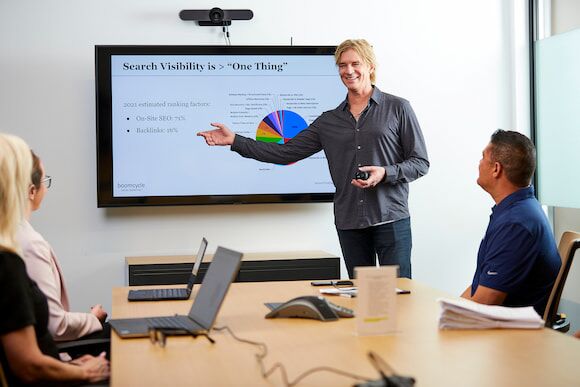
Website Design Fundamentals: Crafting a User-Friendly Experience
In today's digital age, a captivating website can be the make-or-break factor for services and people alike. With the quick development of technology and style patterns, comprehending the essentials of web design is critical. In this short article, we'll check out the core parts that contribute to effective site style, making sure an user-friendly experience that not only attracts visitors but keeps them engaged.
What is Web Design? Comprehending the Basics
Web design refers to the process of producing websites. It includes numerous elements including design, material production, and graphic design. While it may appear web design san francisco bay area uncomplicated, efficient website design requires a mix of imagination and technical skills.
Key Elements of Website Design
Why User Experience (UX) Matters in Web Design
User experience (UX) is at the heart of efficient web design. A properly designed website should not just look good however also operate seamlessly.

Elements of Good UX Design
- Usability: How simple is it for users to browse your site?
- Accessibility: Can everyone access your material, including those with disabilities?
- Performance: Does your site load quickly? Sluggish sites frustrate users.
The Function of a Site Designer in California
A knowledgeable site designer in California comprehends these concepts thoroughly. They combine aesthetic appeals with functionality to create sites that resonate with users while conference company goals.
Web Design Fundamentals: Crafting an Easy To Use Experience
Creating an user-friendly experience includes several methods:
1. Responsive Design
In an era where mobile surfing controls, responsive style guarantees that your website looks terrific on all devices-- be it a desktop or smartphone.
Benefits of Responsive Design
- Improved user experience
- Better SEO rankings
- Increased reach to mobile audiences
2. Intuitive Navigation
Your website's navigation should be simple and instinctive. Users should not have to think hard about where to go next.
Tips for Efficient Navigation
- Use clear labels
- Keep menus short
- Provide search functionality
3. Clear Calls to Action (CTA)
CTAs guide users towards preferred actions-- whether it's signing up for a newsletter or making a purchase.
Examples of Reliable CTAs
- "Start Now"
- "Register Free"
- "Learn More"
4. Content Design and Structure
Content ought to be organized realistically with headings, subheadings, bullet points, and images to break up text blocks.

Best Practices for Material Structuring
- Use H1 for titles, H2 for main sections
- Include alt text for images
- Ensure enough white space
5. Visual Hierarchy
Establishing visual hierarchy helps draw attention to essential components first.

Techniques for Developing Visual Hierarchy
- Size distinctions in text
- Color contrasts
- Placement on the page
Choosing the Right Color Palette
Color plays an essential role in branding and user perception.
Psychology Behind Colors in Web Design
Different colors stimulate different feelings:
|Color|Feeling|| --------------|-------------------|| Blue|Trust|| Red|Seriousness|| Green|Growth|| Yellow|Joy|
Typography Matters in Website Design
Choosing the best fonts can significantly impact readability and brand name voice.
Font Choice Tips
Images & Graphics: Enhancing Your Message
High-quality images inform stories better than words alone.
Best Practices for Utilizing Images on Websites
SEO Principles in Web Design
Search Engine Optimization (SEO) plays an essential role in how quickly users find your website online.
1. Keyword Research study & Implementation
Identify keywords relevant to your audience-- like "web design" or "website designer California"-- and integrate them naturally into your material without keyword stuffing.
2. On-page SEO Techniques
Implement meta tags, alt characteristics for images, and detailed URLs to boost search visibility.
Testing Your Website's Efficiency Before Launching
Before releasing your site, testing its efficiency is essential for making sure everything runs smoothly.
Essential Performance Metrics
|Metric|Importance|| -------------------------|---------------------------|| Load Time|Affects user retention|| Bounce Rate|Indicates engagement level|| Conversion Rate|Steps efficiency|
Gathering User Feedback
User feedback can provide indispensable insights into locations needing improvement within your site's UX/UI design.
Methods for Collecting Feedback
Keeping Up with Patterns in Web Design
The digital landscape develops rapidly; remaining current with trends ensures you remain competitive while boosting user experience.
Current Patterns Affecting Web Design
FAQs About Web Design
- Web style describes the creation of websites encompassing different elements like layout, color design, typography, images, and so on, aimed at supplying users with an appealing experience.
- Very! With increasing mobile usage, responsive style guarantees all users delight in ideal experiences throughout devices.
- An excellent designer integrates imagination with technical understanding while also keeping UX principles front-and-center throughout their work.
- Hiring locally can foster much better interaction due to time zone alignment; plus they'll understand local market nuances!
5. How do I improve my website's packing time?
- Optimize images/graphics size & & utilize browser caching to name a few techniques like using material delivery networks (CDNs).
6. What are common errors made in web design?
- Over-complicated navigation structures or ignoring mobile optimization typically lead numerous designers astray!
Conclusion
In summary, mastering website design fundamentals will empower you as either a company owner or specific seeking an online presence! By prioritizing easy to use experiences through responsive designs, user-friendly navigation systems together with interesting material layouts; you'll certainly develop websites that resonate with visitors while driving conversions efficiently! So whether you're diving into do it yourself web tasks or teaming up carefully with expert designers from California-- remember constantly focus diligently on serving those end-users initially above all else!
And there you have it-- a comprehensive exploration into "Web Design Basics: Crafting a User-Friendly Experience." This guide acts as a vital resource whether you're aiming to improve existing sites or embark on brand-new projects altogether!